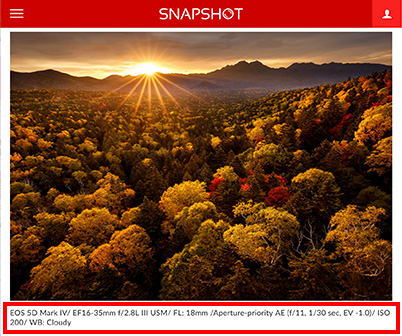Lenses 101
Have you ever looked at a photographic masterpiece and wondered how the photographer managed to capture it? Here’s a not-so-secret secret: It’s in the lenses. How you choose and use them can make the difference between an ordinary shot and a compelling work. The first step is to know your options. Here’s an introduction to the different types of lenses and what they do.

Different lenses let you see the same scene in different ways
The features and specifications you find in DSLR and mirrorless camera bodies can help you take amazing shots, but when it comes to creative expression, the key is in the lens.
Each type of lens has its own unique set of characteristics, which you can harness for different scenes and shooting intentions. From jaw-dropping shots of vast landscapes that go on forever, mysterious close-ups of roses, the action and dynamism of motorsports, and many more, interchangeable lenses provide you with a range of visual expression not possible with a smartphone camera.
For some examples, take a look at the following.
Wide-angle lenses

EOS 5D Mark III/ EF11-24mm f/4L USM/ FL: 11mm/ Aperture-priority AE (f/8.0, 1/500sec, EV±0)/ ISO 100/ WB: Auto
Shot with: Ultra-wide-angle lens
Wide-angle lenses capture a field-of-view that is wider than what the human eye can see. For this reason, they are often used to photograph vast landscapes.
A lens is considered to be wide-angle if its focal length is 35mm and below. If its focal length is 24mm or shorter, it is considered an ultra-wide-angle lens.
Wide-angle lenses also exaggerate perspective, i.e., they can make nearby objects look bigger and nearer, and faraway objects look smaller and even further away. This characteristic is often used in architectural photography to make buildings look more impactful.
Because of the abovementioned strengths in capturing scenery and architecture, wide-angle (including ultra-wide-angle) lenses are great to have on hand when you travel.
Macro lenses

EOS 800D/EF-S35mm f/2.8 Macro IS STM/ FL: 35mm/ Aperture-priority AE(f/9, 0.5sec, EV-1.7)/ ISO 400/ WB: Manual
Type of lens: Macro
Macro lenses are ideal for photographing plants, insects, food, trinkets and accessories, and other small subjects.
This is because they have:
- A very close focusing distance, which means that you can photograph your subject by putting your lens very close to it
- A magnification ratio of at least 1:1, which means that you can still achieve life-size close-ups where the subject fills the frame.
Macro lenses have a very shallow depth-of-field: Only subjects that are very close to the camera will be sharp and in-focus. The surrounding areas will be out-of-focus and blurred with an aesthetic quality called ‘bokeh’, which makes subjects pop.
In fact, because of their ability to create beautiful background bokeh, macro lenses are also often used for portrait photography.
Telephoto lenses

EOS-1D X/ EF100-400mm f/4.5-5.6L IS II USM/ FL: 200mm/ Manual exposure (f/14, 1/60sec, EV±0)/ ISO 50/ WB: Auto
Type of lens: Telephoto
Telephoto lenses “pull in” photographic subjects that are far away and make them look bigger and nearer than they really are. They are ideal for photographing wildlife, sports, car and bike races, and any other subject that is hard for you to shoot from up close.
Telephoto lenses are also known for their compression effect, which makes objects look closer to each other.
Compared to standard (normal) lenses, telephoto lenses can capture images with a larger background blur. This is due to two reasons:
i) A shallower depth-of-field
ii) Out-of-focus distant objects are also "pulled-in" and magnified, so the blurred areas look bigger.
You can use this characteristic to blur out distracting background elements and focus the viewer’s attention on your subject.
A fourth significant characteristic of telephoto lenses is that they result in less distortion compared to other types of lenses such as wide-angle lenses, which makes them ideal for portraiture.
There are three subcategories of telephoto lenses:
- Telephoto prime lenses: Prime lenses with focal length 135mm or more
- Super telephoto prime lenses: Prime lenses with focal length 300mm or more
- Telephoto zoom lenses: Zoom lenses with a telephoto end of 200mm or more
How lenses are classified
1. According to how much of a scene they can capture
i) Angle-of-view (also known as "field-of-view")
This refers to how wide or narrow an area of the entire scene the lens can capture (= ”angle-of-view” or “field-of-view”). The angle-of-view that a lens is capable of is reflected in its focal length.
Examples:
- Wide-angle lens (35mm and below)
- Standard lens (between 35mm and 135mm)
- Telephoto lens (above 135mm)
More details at (b) Wide-angle vs standard vs telephoto vs macro lenses
ii) Fixed or adjustable focal length
Zoom lenses can cover a range of focal lengths.
Prime lenses have a single fixed focal length.
More details at (a) Prime lenses vs zoom lenses
From the above, you get descriptions such as “wide-angle zoom lens” or “telephoto prime lens”.
2. The type of camera that they are made for
Camera manufacturers make lenses for different camera bodies and image sensor sizes. For example, EF-S lenses are tailored for DSLR cameras with APS-C size image sensors such as the EOS 800D.
More details at (c) EF vs EF-S vs EF-M lenses
How do these classifications work?
Understanding the common characteristics of each category of lenses will help you choose the best lens for you needs. For example, let’s say you are going on a trip, and you want a lens that you can use with your EOS 800D to capture the beautiful natural scenery at your destination.
The ideal lens for your needs would probably be all of the following:
- An EF-S lens, as the EOS 800D has an APS-C sensor.
- A zoom lens, as it can cover the same focal length range as a few prime lenses, allowing you to travel lighter.
- An ultra-wide-angle lens, which offers the best angle-of-view for photographing vast natural landscapes.
Taking all the above into consideration, you would probably choose the EF-S10-18mm f/4.5-5.6 IS STM, which falls into all the above categories.
Comparing the different types of lenses
(a) Prime lenses vs zoom lenses
- Zoom lenses allow you to adjust the angle-of-view (focal length) within a certain range
- Prime lenses have a fixed angle-of-view
Zoom lenses are very convenient because you just need one lens to cover a whole set of focal lengths. That is why most kit lenses are zoom lenses.
Meanwhile, prime lenses tend to have better optical performance, as well as feature larger (“brighter”) maximum apertures. This makes them capable of producing amazing images with beautiful, creamy bokeh. When you get more familiar with photography, you will probably find that prime lenses help to expand your creative range.


(b) Wide-angle vs standard vs telephoto vs macro lenses
Wide-angle, standard and telephoto lenses are differentiated by their focal lengths. This reflected in the “XXmm” part of the lens name.
Canon EF lenses can be generalized into the following main categories:
- Wide-angle: Full-frame (35mm film) equivalent focal length of 35mm and below;
- Telephoto: Focal length 135mm and above; or
- Standard (="normal"): Focal length between 35mm and 135mm (although lenses that are 70mm to below 135mm may also be called ‘medium telephoto’ lenses).
Each main category may contain subcategories, such as ultra-wide-angle lenses (under 24mm) and super telephoto lenses (over 400mm).
Macro lenses, which can magnify objects, often have the word “Macro” in their names, after the part that indicates their focal length. However, some lenses without “Macro” in their names, such as the EF24-70mm f/4L IS USM, come with a Macro mode that also allows you to focus at very close distances.




These lenses are made for different Canon camera bodies. Generally,
- EF lenses are made for full-frame DSLR camera bodies;
- EF-S lenses are made for DSLR cameras with APS-C sensors; and
- EF-M lenses are made for mirrorless cameras.
However, this is not exclusive, because EF lenses can also be used on APS-C cameras, and you can also use EF and EF-S lenses with a mirrorless camera with the help of a mount adapter.

* With adapter
Note this: Crop factor
If you decide to attach an EF lens onto an APS-C DSLR or mirrorless camera, the resulting image will look like you used a longer focal length than you actually did. This is called an APS-C sensor crop factor, and you will need to take it into account in your composition.
On Canon equipment, the APS-C sensor crop factor is 1.6 times. This means that if you shoot with a 50mm lens on an APS-C or mirrorless camera, the resulting image has a focal length that is equivalent to an image shot at 80mm (50mm x 1.6x) on a full-frame camera.
What should I consider when choosing lenses?
With over 90 lenses in Canon’s EF lens line-up, users are spoilt for choice. So how do you choose the lens that best suits your needs?
1. Consider the merits and demerits of each type of lens. For example, telephoto zoom lenses can capture faraway objects close up, but they also tend to be bigger and heavier than standard lenses. Meanwhile, macro lenses provide a unique perspective but are very sensitive to camera shake, which means you will probably need to use a tripod.


A camera with a standard zoom lens (left), and with a telephoto zoom lens (right). The camera body is the same for both, but the different lenses change the total weight and how the camera feels in your hands.
2. Consider your camera, your shooting style and the kind of images you want to shoot. Most of the images here on SNAPSHOT have the name of the lens used to shoot them in the shooting information. If you come across an image you really like, study the lens that was used—even if the exact lens model is not suitable for your needs, it might help you to narrow down your options to similar models!

If you see an image you really like, look for the lens name in the shooting information.
Summing up
Ultimately, the best lens for you is the lens that helps you take the images that you envision. To find it requires knowing your needs, and knowing which lenses can meet them. The first part is a constant process of learning, exploration and self-discovery, and evolves as you grow as a photographer. The second part is about knowing your options.
Here on SNAPSHOT, you will find the information to help with both parts. Our Lens Basics series will tell you more about the different types of lenses: Their merits and demerits, unique characteristics, and how you can use them. You can also refer to the various lens reviews and impressions to find out more about specific models of lenses. Hopefully, these will help you in your quest to find the perfect match.
Column: The EF lens series—supporting photography all over the world

EF lenses are interchangeable lenses designed for Canon’s EOS cameras. As of 2017, over 130 million EF lenses have been manufactured worldwide since 1987. As leaders in innovation, reliability and optical brilliance, EF lenses are often the first in the world to adopt new technologies such as in-lens image stabilisation (IS).
There are currently 93 lenses in the EF lens lineup. This includes large aperture, macro and fish-eye lenses, and focal lengths ranging from an ultra-wide angle 8mm to a super telephoto 800mm. Together, they offer users a myriad of possibilities in photographic expression with just one EOS camera body.
Read more about the history of EF lenses here:
[Part 1] The Dawn Era – Birth of the Fully Electronic Mount
[Part 2] The Growth Era – Advent of the Digital Age
[Part 3] The Transition and Enhancement Era – Lenses for High-resolution Cameras
Receive the latest update on photography news, tips and tricks.
Be part of the SNAPSHOT Community.
Sign Up Now!































